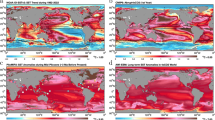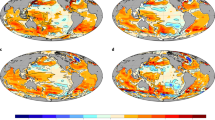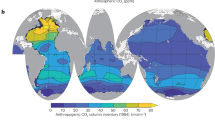Abstract
Oceanic uptake of carbon dioxide substantially reduces the rate at which anthropogenic carbon accumulates in the atmosphere1, slowing global climate change. Some studies suggest that the rate at which the oceans take up carbon has significantly decreased in recent years2,3,4,5,6,7,8. Others suggest that decadal variability confounds the detection of long-term trends9,10,11. Here, we examine trends in the partial pressure of carbon dioxide in the surface waters of three large biogeographic regions in the North Atlantic, using observational data collected between 1981 and 2009. We compare these oceanic observations with trends in atmospheric carbon dioxide levels, taken from a global observational network. We show that trends in oceanic carbon dioxide concentrations are variable on a decadal timescale, often diverging from trends in atmospheric carbon dioxide. However, when the entire 29-year period is considered, oceanic trends converge with atmospheric trends in all three regions; it takes 25 years for this long-term trend to emerge and overcome the influence of decadal-scale variability. Furthermore, in the southernmost biome, the data suggest that warming—driven by a multidecadal climate oscillation and anthropogenic forcing12,13—has started to reduce oceanic uptake of carbon in recent years.
This is a preview of subscription content, access via your institution
Access options
Subscribe to this journal
Receive 12 print issues and online access
$259.00 per year
only $21.58 per issue
Buy this article
- Purchase on Springer Link
- Instant access to full article PDF
Prices may be subject to local taxes which are calculated during checkout


Similar content being viewed by others
References
Denman, K. L. et al. in IPCC Climate Change 2007: The Physical Science Basis (eds Solomon, S. et al.) 499–587 (Cambridge Univ. Press, 2007).
Schuster, U. et al. Trends in North Atlantic sea-surface fCO2 from 1990 to 2006. Deep-Sea Res. II 56, 620–629 (2009).
Watson, A. J. et al. Tracking the variable North Atlantic sink for atmospheric CO2 . Science 326, 1391–1393 (2009).
Le Quéré, C. et al. Trends in the sources and sinks of carbon dioxide. Nature Geosci. 2, 831–836 (2009).
Corbiere, A., Metzl, N., Reverdin, G., Brunet, C. & Takahashi, T. Interannual and decadal variability of the oceanic carbon sink in the North Atlantic subpolar gyre. Tellus B 59, 168–178 (2007).
Metzl, N. et al. Recent acceleration of the sea surface fCO2 growth rate in the North Atlantic subpolar gyre (1993–2008) revealed by winter observations. Glob. Biogeochem. Cycles 24, GB4004 (2010).
Le Quéré, C., Takahashi, T., Buitenhuis, E. T., Rödenbeck, C. & Sutherland, S. C. Impact of climate change on the global oceanic sink of CO2 . Glob. Biogeochem. Cycles 24, GB4007 (2010).
Canadell, J. et al. Contributions to accelerating atmospheric CO2 growth from economic activity, carbon intensity, and efficiency of natural sinks. Proc. Natl Acad. Sci. USA 104, 18886–18870 (2007).
Thomas, H. et al. Changes in the North Atlantic Oscillation influence CO2 uptake in the North Atlantic over the past 2 decades. Glob. Biogeochem. Cycles 22, GB4027 (2008).
Ullman, D. J., McKinley, G. A., Bennington, V. & Dutkiewicz, S. Trends in the North Atlantic carbon sink: 1992–2006. Glob. Biogeochem. Cycles 23, GB4011 (2009).
Gruber, N. Fickle trends in the ocean. Nature 458, 155–156 (2009).
Ting, M-F., Kushnir, Y., Seager, R. & Li, C-H. Forced and internal twentieth-century SST trends in the North Atlantic. J. Clim. 22, 1469–1481 (2009).
Löptien, U. & Eden, C. Multidecadal CO2 uptake variability of the North Atlantic. J. Geophys. Res. 115, D12113 (2010).
Takahashi, T. et al. Climatological mean and decadal change in surface ocean pCO2, and net sea–air CO2 flux over the global oceans. Deep-Sea Res. II 56, 554–577 (2009).
Bates, N. R. Interannual variability of the oceanic CO2 sink in the subtropical gyre of the North Atlantic Ocean over the last 2 decades. J. Geophys. Res. 112, C09013 (2007).
Rödenbeck, C. Estimating CO2 Sources and Sinks from Atmospheric Mixing Ratio Measurements using a Global Inversion of Atmospheric Transport (Tech. Rep. 6, Max-Planck-Inst. for Biogeochem. Jena, 2005) available via: http://go.nature.com/j1SCg7.
Sarmiento, J. L. et al. Response of ocean ecosystems to climate warming. Glob. Biogeochem. Cycles 18, GB3003 (2004).
Takahashi, T., Sutherland, S. C. & Kozyr, A. Global Ocean Surface Water Partial Pressure of CO2 Database: Measurements Performed during 1957-2009 (Version 2009). (ORNL/CDIAC-152, NDP-088r. CDIAC, ORNL, US DOE, Oak Ridge, Tennessee, 10.3334/CDIAC/otg.ndp088r, 2010).
Follows, M., Ito, T. & Dutkiewicz, S. On the solution of the carbonate chemistry system in ocean biogeochemistry models. Ocean Model. 12, 290–301 (2006).
GLOBALVIEW-CO2: Cooperative Atmospheric Data Integration Project—Carbon Dioxide, Reference Matrix. (CD-ROM, ftp.cmdl.noaa.gov, Path: ccg/co2/GLOBALVIEW, NOAA ESRL, Boulder, CO, 2010).
Takahashi, T. et al. Global sea–air CO2 flux based on climatological surface ocean pCO2, and seasonal biological and temperature effects. Deep-Sea Res. II 49, 1601–1622 (2002).
Reverdin, G. North Atlantic subpolar gyre surface variability (1895–2009). J. Clim. 23, JCLI3493.1 (2010).
Skjelvan, I., Falck, E., Rey, F. & Kringstad, S. B. Inorganic carbon time series at Ocean Weather Station M in the Norwegian Sea. Biogeosci. 5, 549–560 (2008).
Häkkinen, S. & Rhines, P. B. Shifting surface currents in the northern North Atlantic Ocean. J. Geophys. Res. 114, C04005 (2009).
Lozier, M. S. et al. The spatial pattern and mechanisms of heat-content change in the North Atlantic. Science 319, 800–803 (2008).
Knorr, W. Is the airborne fraction of anthropogenic CO2 emissions increasing? Geophys. Res. Lett. 36, L21710 (2009).
Sarmiento, J. L. et al. Trends and regional distributions of land and ocean carbon sinks. Biogeoscience 7, 2351–2367 (2010).
Reynolds, R. W. et al. Daily high-resolution-blended analyses for sea surface temperature. J. Clim. 20, 5473–5496 (2007).
Levitus, S. (ed.) World Ocean Atlas 2005, Volume 1 and 2 (NOAA Atlas NESDIS 61, US Government Printing Office, 2005).
Key, R. et al. A global ocean carbon climatology: Results from Global Data Analysis Project (GLODAP). Glob. Biogeochem. Cycles 18, GB4031 (2004).
Acknowledgements
G.A.M. and A.R.F. acknowledge funding from NASA (07-NIP07-0036). The SURATLANT Project is supported by Institut National des Sciences de l’Univers (INSU, as contribution of the ORE SSS) and Institut Paul Emile Victor (IPEV) in France. This work was also supported by French program LEFE/FlamenCO2, a component of SOLAS-France and European Integrated Project CARBOOCEAN (511176). T.T. is supported by a NOAA grant (NA080AR4320754).
Author information
Authors and Affiliations
Contributions
G.A.M designed the study and wrote the manuscript. A.R.F. did the data analysis. T.T. developed the oceanic pCO2 database. N.M. synthesized the SURATLANT data. All authors discussed and revised the manuscript.
Corresponding author
Ethics declarations
Competing interests
The authors declare no competing financial interests.
Supplementary information
Supplementary Information
Supplementary Information (PDF 2210 kb)
Rights and permissions
About this article
Cite this article
McKinley, G., Fay, A., Takahashi, T. et al. Convergence of atmospheric and North Atlantic carbon dioxide trends on multidecadal timescales. Nature Geosci 4, 606–610 (2011). https://doi.org/10.1038/ngeo1193
Received:
Accepted:
Published:
Issue Date:
DOI: https://doi.org/10.1038/ngeo1193
This article is cited by
-
Carbonate Chemistry and the Potential for Acidification in Georgia Coastal Marshes and the South Atlantic Bight, USA
Estuaries and Coasts (2024)
-
Multi-annual variability of pCO2(aq) and air-water CO2 flux in the mangrove-dominated Dhamra Estuary draining into the Bay of Bengal (India)
Environmental Science and Pollution Research (2023)
-
RETRACTED ARTICLE: New land-use-change emissions indicate a declining CO2 airborne fraction
Nature (2022)
-
Modulation of ocean acidification by decadal climate variability in the Gulf of Alaska
Communications Earth & Environment (2021)
-
Contrasting drivers and trends of ocean acidification in the subarctic Atlantic
Scientific Reports (2021)



